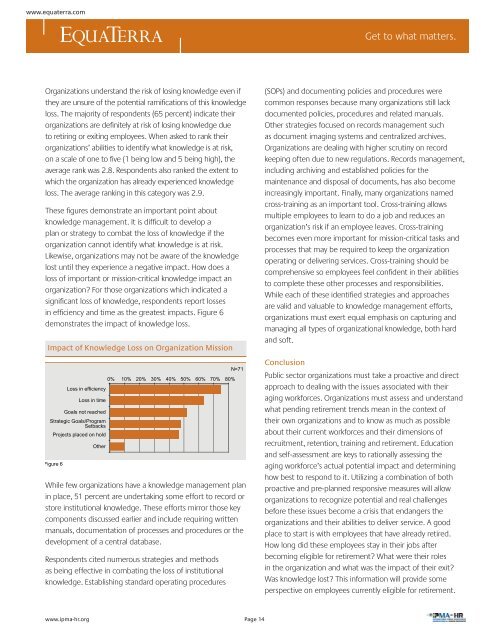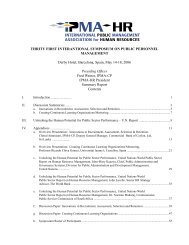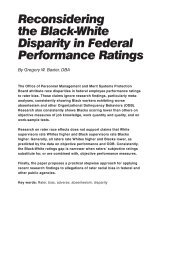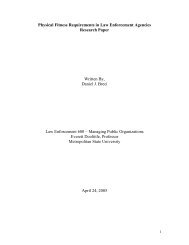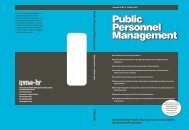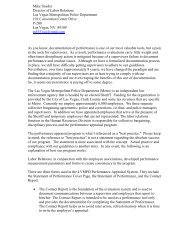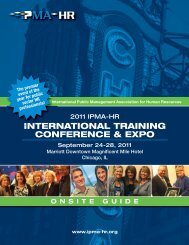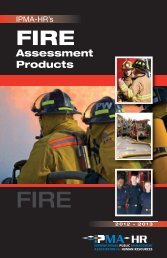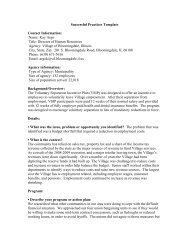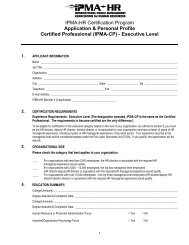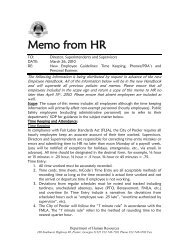The Impact of the Aging Workforce on Public Sector Organizations ...
The Impact of the Aging Workforce on Public Sector Organizations ...
The Impact of the Aging Workforce on Public Sector Organizations ...
You also want an ePaper? Increase the reach of your titles
YUMPU automatically turns print PDFs into web optimized ePapers that Google loves.
www.equaterra.comGet to what matters.Organizati<strong>on</strong>s understand <str<strong>on</strong>g>the</str<strong>on</strong>g> risk <str<strong>on</strong>g>of</str<strong>on</strong>g> losing knowledge even if<str<strong>on</strong>g>the</str<strong>on</strong>g>y are unsure <str<strong>on</strong>g>of</str<strong>on</strong>g> <str<strong>on</strong>g>the</str<strong>on</strong>g> potential ramifi cati<strong>on</strong>s <str<strong>on</strong>g>of</str<strong>on</strong>g> this knowledgeloss. <str<strong>on</strong>g>The</str<strong>on</strong>g> majority <str<strong>on</strong>g>of</str<strong>on</strong>g> resp<strong>on</strong>dents (65 percent) indicate <str<strong>on</strong>g>the</str<strong>on</strong>g>irorganizati<strong>on</strong>s are defi nitely at risk <str<strong>on</strong>g>of</str<strong>on</strong>g> losing knowledge dueto retiring or exiting employees. When asked to rank <str<strong>on</strong>g>the</str<strong>on</strong>g>irorganizati<strong>on</strong>s’ abilities to identify what knowledge is at risk,<strong>on</strong> a scale <str<strong>on</strong>g>of</str<strong>on</strong>g> <strong>on</strong>e to fi ve (1 being low and 5 being high), <str<strong>on</strong>g>the</str<strong>on</strong>g>average rank was 2.8. Resp<strong>on</strong>dents also ranked <str<strong>on</strong>g>the</str<strong>on</strong>g> extent towhich <str<strong>on</strong>g>the</str<strong>on</strong>g> organizati<strong>on</strong> has already experienced knowledgeloss. <str<strong>on</strong>g>The</str<strong>on</strong>g> average ranking in this category was 2.9.<str<strong>on</strong>g>The</str<strong>on</strong>g>se fi gures dem<strong>on</strong>strate an important point aboutknowledge management. It is diffi cult to develop aplan or strategy to combat <str<strong>on</strong>g>the</str<strong>on</strong>g> loss <str<strong>on</strong>g>of</str<strong>on</strong>g> knowledge if <str<strong>on</strong>g>the</str<strong>on</strong>g>organizati<strong>on</strong> cannot identify what knowledge is at risk.Likewise, organizati<strong>on</strong>s may not be aware <str<strong>on</strong>g>of</str<strong>on</strong>g> <str<strong>on</strong>g>the</str<strong>on</strong>g> knowledgelost until <str<strong>on</strong>g>the</str<strong>on</strong>g>y experience a negative impact. How does aloss <str<strong>on</strong>g>of</str<strong>on</strong>g> important or missi<strong>on</strong>-critical knowledge impact anorganizati<strong>on</strong>? For those organizati<strong>on</strong>s which indicated asignifi cant loss <str<strong>on</strong>g>of</str<strong>on</strong>g> knowledge, resp<strong>on</strong>dents report lossesin effi ciency and time as <str<strong>on</strong>g>the</str<strong>on</strong>g> greatest impacts. Figure 6dem<strong>on</strong>strates <str<strong>on</strong>g>the</str<strong>on</strong>g> impact <str<strong>on</strong>g>of</str<strong>on</strong>g> knowledge loss.<str<strong>on</strong>g>Impact</str<strong>on</strong>g> <str<strong>on</strong>g>of</str<strong>on</strong>g> Knowledge Loss <strong>on</strong> Organizati<strong>on</strong> Missi<strong>on</strong>Figure 60% 10% 20% 30% 40% 50% 60% 70% 80%Loss in efficiencyLoss in timeGoals not reachedStrategic Goals/ProgramSetbacksProjects placed <strong>on</strong> holdO<str<strong>on</strong>g>the</str<strong>on</strong>g>rWhile few organizati<strong>on</strong>s have a knowledge management planin place, 51 percent are undertaking some effort to record orstore instituti<strong>on</strong>al knowledge. <str<strong>on</strong>g>The</str<strong>on</strong>g>se efforts mirror those keycomp<strong>on</strong>ents discussed earlier and include requiring writtenmanuals, documentati<strong>on</strong> <str<strong>on</strong>g>of</str<strong>on</strong>g> processes and procedures or <str<strong>on</strong>g>the</str<strong>on</strong>g>development <str<strong>on</strong>g>of</str<strong>on</strong>g> a central database.Resp<strong>on</strong>dents cited numerous strategies and methodsas being effective in combating <str<strong>on</strong>g>the</str<strong>on</strong>g> loss <str<strong>on</strong>g>of</str<strong>on</strong>g> instituti<strong>on</strong>alknowledge. Establishing standard operating proceduresN=71(SOPs) and documenting policies and procedures werecomm<strong>on</strong> resp<strong>on</strong>ses because many organizati<strong>on</strong>s still lackdocumented policies, procedures and related manuals.O<str<strong>on</strong>g>the</str<strong>on</strong>g>r strategies focused <strong>on</strong> records management suchas document imaging systems and centralized archives.Organizati<strong>on</strong>s are dealing with higher scrutiny <strong>on</strong> recordkeeping <str<strong>on</strong>g>of</str<strong>on</strong>g>ten due to new regulati<strong>on</strong>s. Records management,including archiving and established policies for <str<strong>on</strong>g>the</str<strong>on</strong>g>maintenance and disposal <str<strong>on</strong>g>of</str<strong>on</strong>g> documents, has also becomeincreasingly important. Finally, many organizati<strong>on</strong>s namedcross-training as an important tool. Cross-training allowsmultiple employees to learn to do a job and reduces anorganizati<strong>on</strong>’s risk if an employee leaves. Cross-trainingbecomes even more important for missi<strong>on</strong>-critical tasks andprocesses that may be required to keep <str<strong>on</strong>g>the</str<strong>on</strong>g> organizati<strong>on</strong>operating or delivering services. Cross-training should becomprehensive so employees feel c<strong>on</strong>fi dent in <str<strong>on</strong>g>the</str<strong>on</strong>g>ir abilitiesto complete <str<strong>on</strong>g>the</str<strong>on</strong>g>se o<str<strong>on</strong>g>the</str<strong>on</strong>g>r processes and resp<strong>on</strong>sibilities.While each <str<strong>on</strong>g>of</str<strong>on</strong>g> <str<strong>on</strong>g>the</str<strong>on</strong>g>se identifi ed strategies and approachesare valid and valuable to knowledge management efforts,organizati<strong>on</strong>s must exert equal emphasis <strong>on</strong> capturing andmanaging all types <str<strong>on</strong>g>of</str<strong>on</strong>g> organizati<strong>on</strong>al knowledge, both hardand s<str<strong>on</strong>g>of</str<strong>on</strong>g>t.C<strong>on</strong>clusi<strong>on</strong><strong>Public</strong> sector organizati<strong>on</strong>s must take a proactive and directapproach to dealing with <str<strong>on</strong>g>the</str<strong>on</strong>g> issues associated with <str<strong>on</strong>g>the</str<strong>on</strong>g>iraging workforces. Organizati<strong>on</strong>s must assess and understandwhat pending retirement trends mean in <str<strong>on</strong>g>the</str<strong>on</strong>g> c<strong>on</strong>text <str<strong>on</strong>g>of</str<strong>on</strong>g><str<strong>on</strong>g>the</str<strong>on</strong>g>ir own organizati<strong>on</strong>s and to know as much as possibleabout <str<strong>on</strong>g>the</str<strong>on</strong>g>ir current workforces and <str<strong>on</strong>g>the</str<strong>on</strong>g>ir dimensi<strong>on</strong>s <str<strong>on</strong>g>of</str<strong>on</strong>g>recruitment, retenti<strong>on</strong>, training and retirement. Educati<strong>on</strong>and self-assessment are keys to rati<strong>on</strong>ally assessing <str<strong>on</strong>g>the</str<strong>on</strong>g>aging workforce’s actual potential impact and determininghow best to resp<strong>on</strong>d to it. Utilizing a combinati<strong>on</strong> <str<strong>on</strong>g>of</str<strong>on</strong>g> bothproactive and pre-planned resp<strong>on</strong>sive measures will alloworganizati<strong>on</strong>s to recognize potential and real challengesbefore <str<strong>on</strong>g>the</str<strong>on</strong>g>se issues become a crisis that endangers <str<strong>on</strong>g>the</str<strong>on</strong>g>organizati<strong>on</strong>s and <str<strong>on</strong>g>the</str<strong>on</strong>g>ir abilities to deliver service. A goodplace to start is with employees that have already retired.How l<strong>on</strong>g did <str<strong>on</strong>g>the</str<strong>on</strong>g>se employees stay in <str<strong>on</strong>g>the</str<strong>on</strong>g>ir jobs afterbecoming eligible for retirement? What were <str<strong>on</strong>g>the</str<strong>on</strong>g>ir rolesin <str<strong>on</strong>g>the</str<strong>on</strong>g> organizati<strong>on</strong> and what was <str<strong>on</strong>g>the</str<strong>on</strong>g> impact <str<strong>on</strong>g>of</str<strong>on</strong>g> <str<strong>on</strong>g>the</str<strong>on</strong>g>ir exit?Was knowledge lost? This informati<strong>on</strong> will provide someperspective <strong>on</strong> employees currently eligible for retirement.www.ipma-hr.orgPage 14


